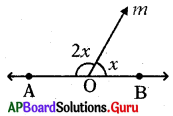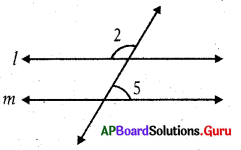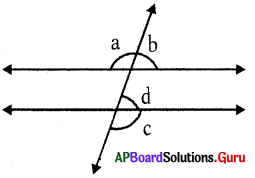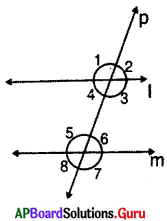Practice the AP 7th Class Maths Bits with Answers 4th Lesson Lines and Angles on a regular basis so that you can attempt exams with utmost confidence.
AP Board 7th Class Maths Bits 4th Lesson Lines and Angles
Multiple Choice Questions :
Question 1.
Union of two rays which has one com¬mon end point is called ________
(A) Line
(B) Ray
(C) Angle
(D) Triangle
Answer:
(C) Angle
Question 2.
If the sum of two angles is 180°, then the angles are called ________
(A) Supplementary
(B) Complementary
(C) Conjugate
(D) Adjacent angles
Answer:
(A) Supplementary
Question 3.
If the sum of two angles is 90°, then the angles are called ________
(A) Supplementary
(B) Complementary
(C) Conjugate
(D) Adjacent angles
Answer:
(B) Complementary
Question 4.
If the sum of ∠P and ∠Q is 360°, then they are called ________
(A) Supplementary
(B) Complementary
(C) Conjugate
(D) Adjacent angles
Answer:
(C) Conjugate
![]()
Question 5.
Supplementary angle of 30° is ________
(A) 180°
(B) 150°
(C) 60°
(D) 90°
Answer:
(B) 150°
Question 6.
If the ratio of supplementary angles is 2 : 3, then the angles are ________
(A) 72°, 108°
(B) 60°, 120°
(C) 50°, 130°
(D) 40°, 140°
Answer:
(A) 72°, 108°
Question 7.
Sum of pair of adjacent angles is 180°, then the angles are called ________
(A) Supplementary
(B) Complementary
(C) Linear pair
(D) Adjacent angles
Answer:
(C) Linear pair
Question 8.
A linear pair of angles must be ________ angles.
(A) Supplementary
(B) Complementary
(C) Adjacent angles
(D) Linear pair
Answer:
(C) Adjacent angles
Question 9.
The sum of the angles at a point on the same side of the line is ________
(A) 90°
(B) 360°
(C) 270°
(D) 180°
Answer:
(D) 180°
Question 10.
Linear pair among the following :
(A) 98°, 102°
(B) 120°, 60°
(C) 180°, 90°
(D) 120°, 150°
Answer:
(B) 120°, 60°
Question 11.
Vertically opposite angles are
(A) equal
(B) adjacent angles
(C) linear pair
(D) not equal
Answer:
(A) equal
Question 12.
A line which intersects the two or more straight lines at distinct points is called a / an ________
(A) Angle
(B) Parallel line
(C) Transversal line
(D) Intersecting line
Answer:
(C) Transversal line
Question 13.
Angles in between two parallel lines are called ________
(A) corresponding angles
(B) alternate interior angles
(C) exterior angles
(D) interior angles
Answer:
(D) interior angles
![]()
Question 14.
Two angles which are on the same side of transversal, one interior and other exterior but not. adjacent are called ________
(A) corresponding angles
(B) alternate interior angles
(C) alternate exterior angles
(D) interior angles
Answer:
(A) corresponding angles
Question 15.
Exterior angles oil either side of the transversal but not adjacent angles are called ________
(A) corresponding angles
(B) alternate interior angles
(C) alternate exterior angles
(D) interior angles
Answer:
(C) alternate exterior angles
Question 16.
Interior angles on same side of a transversal are called ________
(A) corresponding angles
(B) interior angles
(C) co-exterior angles
(D) co-interior angles
Answer:
(D) co-interior angles
Question 17.
If a transversal intersects two lines in such way that the pair of correspond¬ing angles are equal, then the two lines are ________
(A) intersecting lines
(B) parallel lines
(C) transversal lines
(D) none
Answer:
(B) parallel lines
Question 18.
When the co-interior angles are supplementary, then the lines are ________
(A) intersecting lines
(B) parallel lines
(C) transversal lines
(D) none
Answer:
(B) parallel lines
Question 19.
Examples for linear pair of angles in our surroundings ________
(A) pen stand
(B) electrical pole
(C) tree
(D) all of the above
Answer:
(D) all of the above
Question 20.
Number of transversal lines can be drawn two distinct lines are ________
(A) 1
(B) 2
(C) infinite
(D) none
Answer:
(C) infinite
Question 21.
From the adjacent figure ∠p = ________

(A) 100°
(B)70°
(C) 80°
(D) 60
Answer:
(C) 80°
Question 22.
From the given figure ∠x =________

(A) 60°
(B) 50°
(C) 70°
(D) 90°
Answer:
(A) 60°
Question 23.
If two lines intersect each other, then the number of common points they have ________
(A) 1
(B) 2
(C) 4
(D) infinity
Answer:
Question 24.
Which of the following angle can’t be formed by a normal scissors?
(A) obtuse angle
(B) acute angle
(C) right angle
(D) straight angle
Answer:
(A) 1
![]()
Question 25.
In the following figure,
∠x + ∠z = ________

(A) 20°
(B) 40°
(C) 160°
(D) 80°
Answer:
(B) 40°
Fill in the blanks :
Question 1.
If the sum of two angles is 360°, then the angles are called ________
Answer:
Conjugate angles
Question 2.
If the sum of ∠A and ∠B is 180°, then they are called ________
Answer:
Supplementary angles
Question 3.
If the sum of ∠X and ∠Y is 90°, then they are called ________
Answer:
Complementary angles
Question 4.
Conjugate angle of 120° is ________
Answer:
240°
Question 5.
Complementary angle of 40° is ________
Answer:
50°
Question 6.
In the ratio of complementary angles is 4 : 5, then the angles are ________
Answer:
40°, 50°
Question 7.
If ∠X and ∠Y are supplementary then ________
Answer:
90°
Question 8.
If the two angles have a common vertex, common arm and lie on either side of the common arm they are called ________
Answer:
adjacent angles
Question 9.
Adjacent angles need not be ________
Answer:
complementary or supplementary
![]()
Question 10.
Linear pair of angles are ________
Answer:
supplementary
Question 11.
Adjacent angles need, not be ________
Answer:
linear pair
Question 12.
The sum of all the angles at a point is ________
Answer:
360°
Question 13.
When two straight lines intersect each other, the pair of opposite angles formed at the point of intersection are called ________
Answer:
vertically opposite angles
Question 14.
Angles that are not in between two parallel lines are called ________
Answer:
exterior angles
Question 15.
Interior angles on either side of the transversal but not adjacent angles are called ________
Answer:
alternate interior angles
Question 16.
Exterior angles on same side of transversal are called ________
Answer:
Co-exterior angles
Question 17.
Two coplanar lines which do not intersect at any point are called as ________
Answer:
parallel lines
Question 18.
When a transversal intersect a pair of parallel lines, then the alternate interior angles are ________
Answer:
equal
Question 19.
If the alternate interior angles are equal, then the lines are ________
Answer:
parallel
Question 20.
In the figure the value of x is ________

Answer:
60°
Question 21.
In the figure ∠2 = ∠5, then the lines are ________

Answer:
intersecting lines
![]()
Question 22.
Supplementary of an angle is three times the angle, then the angle is
Answer:
60°
Question 23.
From the given figure ∠a: ∠b = 2: 1, then ∠c – ∠d = ________

Answer:
60°
Question 24.
A transversal line intersects two distinct lines in ________ distinct points.
Answer:
two
Question 25.
An angle is double of its supplement, then the measure of the angle is ________
Answer:
60°
Match the following :
Question 1.
| Group A | Group B |
| 1. Sum of Complementary angles | (A) 45° |
| 2. Sum of Conjugate angles | (B) 90° |
| 3. Sum of Supplementary angles | (C) 150° |
| 4. Acute angle | (D) 180° |
| 5. Obtuse angle | (E) 360° |
Answer:
| Group A | Group B |
| 1. Sum of Complementary angles | (B) 90° |
| 2. Sum of Conjugate angles | (E) 360° |
| 3. Sum of Supplementary angles | (D) 180° |
| 4. Acute angle | (A) 45° |
| 5. Obtuse angle | (C) 150° |
Question 2.
| Group A | Group B |
| 1. Supplementary angle of 30° is | (A) 240° |
| 2. Complementary angle of 45° is | (B) 130° |
| 3. Conjugate of 120° is | (C) 70° |
| 4. Linear pair of 50° is | (D) 150° |
| 5. the Corresponding angle of 70° is | (E) 45° |
Answer:
| Group A | Group B |
| 1. Supplementary angle of 30° is | (D) 150° |
| 2. Complementary angle of 45° is | (E) 45° |
| 3. Conjugate of 120° is | (A) 240° |
| 4. Linear pair of 50° is | (B) 130° |
| 5. the Corresponding angle of 70° is | (C) 70° |
![]()
Question 3.
From the adjacent figure,

| Group A | Group B |
| 1. Interior angles | (A) (∠4, ∠5), (∠3, ∠6) |
| 2. Exterior angles | (B) ∠3, ∠4, ∠5, ∠6 |
| 3. Corresponding angles | (C) (∠1, ∠7), (∠2, ∠5) |
| 4. Alternate exterior angles | (D) ∠1, ∠2, ∠7, ∠8 |
| 5. Co interior angles | (E) (∠1, ∠5), (∠2, ∠5), (∠4, ∠8), (∠3, ∠7) |
Answer:
| Group A | Group B |
| 1. Interior angles | (B) ∠3, ∠4, ∠5, ∠6 |
| 2. Exterior angles | (D) ∠1, ∠2, ∠7, ∠8 |
| 3. Corresponding angles | (E) (∠1, ∠5), (∠2, ∠5), (∠4, ∠8), (∠3, ∠7) |
| 4. Alternate exterior angles | (C) (∠1, ∠7), (∠2, ∠5) |
| 5. Co interior angles | (A) (∠4, ∠5), (∠3, ∠6) |